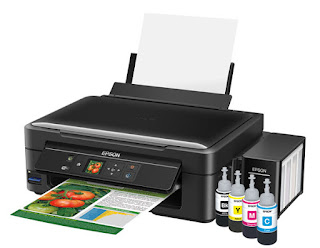This week is my last collection of heavenly tech highlights to add to your Christmas wish list.
I'm sure any one of these would be guaranteed to pin a smile
on the face of even the most demanding digital devil.
To begin, what could be more appropriate than the answer to all your Christmas
calendar printing requirements?...
The Epson Ecotank Printer Range.
Well, it's been almost 6 months since I installed my trusty Epson Ecotank and guess what? It's still printing strong without a single refill.
Okay, maybe I'm still 18 months away from hitting Epson's 2 year promise, but I certainly can't complain so far.
This is the printer that is guaranteed to get all those home-made Christmas cards done without a problem. In fact, it's such a breakthrough in home-printing, Epson's Ecotank technology has just won the prestigious CES Innovation Award.
If you've always wanted a tablet, but you've always hated
tablets...
So light and skinny, it's almost like using a phone, except the functionality is more like a real computer.
Lightning fast, super smooth operation and the battery life puts it among the leaders in its class.
Click here for my full review
Over the last 2 weeks I've put a mid-priced phone in this
slot, but you can go even cheaper...
Just because this phone is priced low, doesn't mean it won't perform.
Sure you'll have to compromise on sheer power and storage space, but if you keep it simple when you're using your handset, there probably isn't more bang for your buck out there... unless you steal one.
Click here for my full review
And it actually looks quite cool too. Nobody has to know what a cheapskate you were.
At the other end of the scale...
The Galaxy Note 5.
Meet the best phone I have ever used. Full stop.
I keep trying to find something this thing can't do. I've had it a while now. Haven't found anything yet.
Apart from working so well I suspect there's alien technology inside, the battery life is off the charts - not just for a phone with a screen this size, for any phone.
Click here for my full review
I can now die a happy man having used this phone.
Let's finish up with the wearable that finally got it...
Let's finish up with the wearable that finally got it...
The Huawei Watch.
I know; looks exactly like a watch, right?
What a crazy idea.
Easily the most stylish smart watch on the market, although
essentially the same Android Wear device as many of its uglier competitors.
If looking good matters as much to your geek as being geeky,
this is the luxury gift that tells him or her you really love their brain.
Those were this year's most addictive, alluring and
downright genius tech treats.
Can't wait to find out what they'll come up with in 2016. Maybe that hover-car
will finally be a reality. Hard to wrap though...























